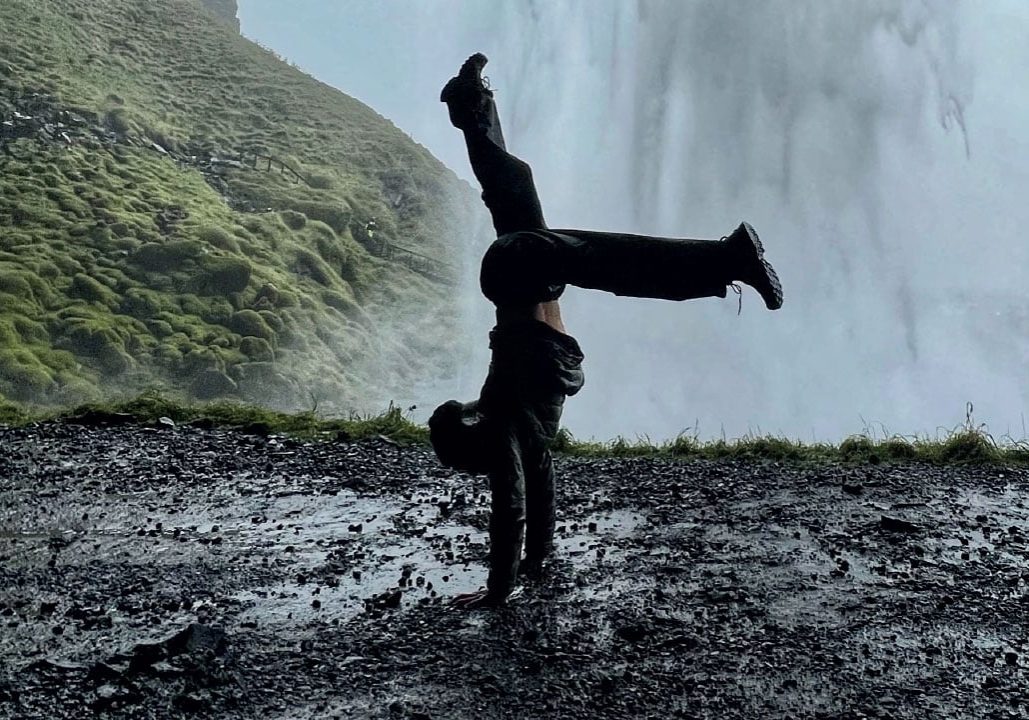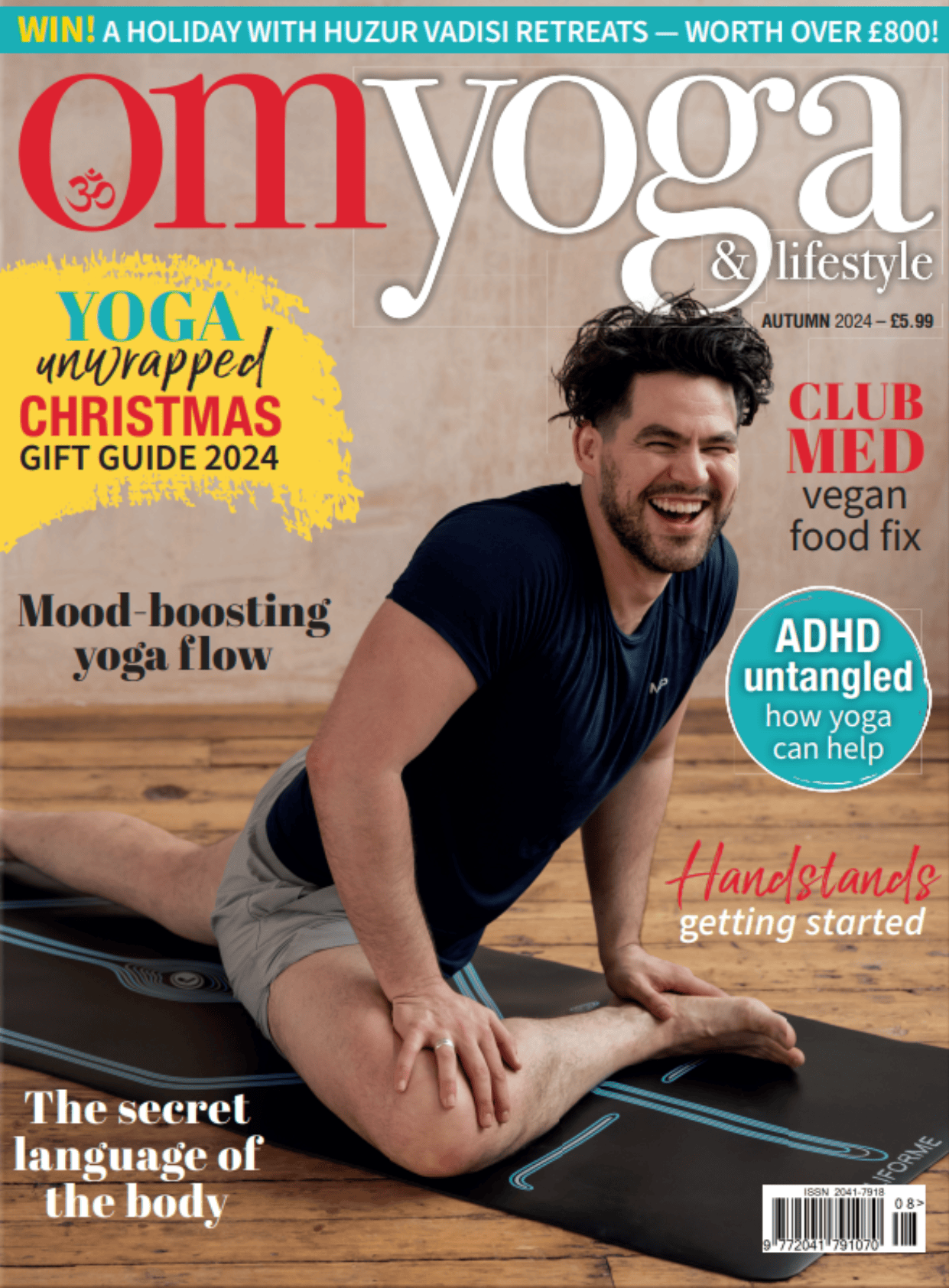
Growing Handstands
Like digging in the dirt to plant a tree, learning handstand first starts with
developing roots. By Andrea Marcum
Reading time: 4 minutes
Misjudging a handstand and crashing to the floor is about as much fun as getting unexpectedly fired from your job or having your heart broken. I believe, though, that falling out of a handstand is essential to growing a better understanding of who we are.
Handstands are fantastic, living laboratories. In them, suddenly upside down needs to become right side up, and we must muster the courage to embrace the process of adjusting to a new perspective no matter how messy it gets.
Similarly, our lives can feel messy, miscalculated and out of control when it comes to managing our schedule, dealing with deadlines, handling responsibilities, or trying not to consume the entire box of dark chocolate covered almonds in one sitting. Whether we’re attempting to balance our cravings, calendars, cheque books or handstand, these struggles are an integral step towards self-discovery.
If we litter our inversions — or our lives — with impossible expectations, we pin ourselves beneath frustration and impatience, which, in turn, erode the bravery and humility it takes to try again. We must be willing to both fall down and get back up. Personally, I’ve tumbled many times out of my handstand, but as a result, into a new headspace. Stumbles are the seeds of learning. It’s what we do with these seeds that allow us to grow and eventually enjoy the fruits of our labour.
A tree grows in two directions at the same time: down into the earth and up towards the light of the sun. These are the tree’s root and fruit systems. The seed of an unformed tree grows down into the dark, damp soil pushing against resistance in order to establish itself. Above ground, there’s no evidence of growth, but subterranean progress known as gravitropism (growing in the direction of gravity) is in full effect. In fact, the roots that are growing down there look very similar to what the tree will eventually look like above ground.
The root system of a handstand resembles that of a tree. We place our hands in the dark, damp soil, learn to navigate resistance, patience and proprioception (where we are in space) as we plant the seed of our someday[1]handstand. Subterranean unseen progress abounds as we practice foundational poses like plank, down dog, bakasana and L pose (walking our feet up the wall).
These postures act as a greenhouse where we can safely begin to shift from root to shoot. Visions of free-standing IG-worthy handstands dance in our learning-to-be inverted heads, our egos are upended and our wrists scream at us for trying to stand on them like ankles. But what we’re learning is invaluable, and not just on our mat.
As a tree shoots through the surface, it grows out of the damp, dark resistance and towards the light (phototropism). It’s tempting to see only the surface and forget that a balance of root and shoot is necessary for any actual fruit. The same is true of our handstand. We need to continue to grow our roots, even as we begin to convince our hips and legs to reach towards the light. We’re starting to kick up into the unknown; but our roots are an important reminder to stay grounded as we inevitably wobble and fall.
Yes, physically grounded to grow our pose, but kicking up into a handstand is a metaphor for kicking up into a new relationship, a new career, location or creative idea. Deep roots support our ever-widening branches.
Nature is an extraordinary guide when it comes to unearthing our own true nature, and handstand is an arboretum from which to grow the limbs of our yoga tree. It’s natural for things to take time to take root.
If we remember that, we can enjoy playing in the dirt. Whether you’re in the weeds of your first draft, the mud of a first date or muck of trying to get your shoulders over your wrists and hips over your shoulders, you are growing in two different directions when you choose to grow like a tree.
Here's a little dirt for you to play in for now:
Plank pose: Shift into a plank. Imagine your core like an apple core down the midline of your body. Note that this is merely your handstand parallel to the floor. Enjoy the powerful feeling of this pose like wind in your inversion-bound sails.
Core strength: From down dog, shift into plank. Bring your right knee to your chest. Feel your deep core stabilising muscles strengthen. You may want to keep your opposite knee down like a kickstand until you become stronger. The shift forward can feel a bit spooky when you step that foot as a launch for the full flight of a handstand so it’s nice to test drive it here — be sure to do both sides.
‘L’ pose: Take a down dog with your heels up the wall. Begin to walk your feet up the wall. Stop when they are hip height creating an ‘L’ shape. This is a great way to add training wheels to your handstand. Be patient. Allow yourself time to get familiar with upside down becoming right side up. In fact, you could stay with ‘L’ pose, forget about the next handstand step and still lead a very happy and fulfilled life…just saying!
Handstands
It’s best to use a wall until your balance is solid. Not a wall full of electrical outlets, artwork and windows, but a clean, safe space with plenty of room for you to land safely.
- Start in a short down dog with your hands about six inches away from the wall you are facing.
- Shift your body weight forward, shoulders over the wrists, gazing right where the wall meets the floor to better orient yourself before take-off.
- With a bend to the knee, step one foot closer to the wall (this will be your launching leg). Activate your back leg, extending energy through the heel (this will be your lifting leg).
- Begin with light hops pushing off your bottom foot, asking your back leg to leave the ground. Think finesse, float and fun. This may be enough to experiment with for a while.
No need to rush the process, you’re just laying down roots. Eventually both legs come to the wall and heels extend to the sky for the full pose.
Stay playful, a bit silly and to be willing to turn things upside down a little bit at a time. Inversions and arm balances can help to stave off depression and burnout in our super-serious lives, so dig in and enjoy.
Andrea Marcum leads retreats around the world and is the author of Close to OM: Stretching Yoga From Your Mat To Your Life. Practice with her at: andreamarcum.com


